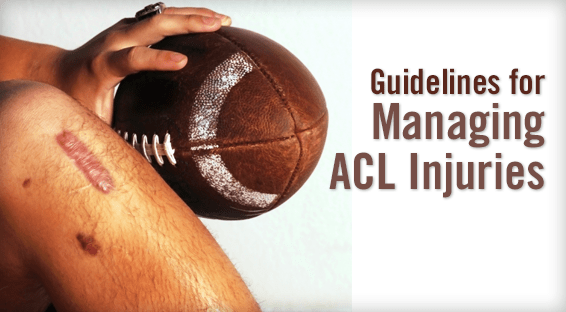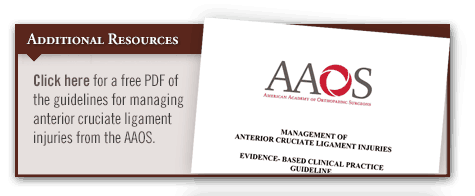Anterior cruciate ligament (ACL) tears are among the most common injuries that occur in athletes participating in high-demand sports. Research has shown that people who suffer these injuries are at higher risk for developing arthritis later in life, and women are more likely to suffer an ACL injury with certain sports when compared with men. “Over 100,000 ACL injuries occur each year in the United States,” says Kevin G. Shea, MD. “These injuries are typically treated with surgical reconstruction in young active people, but patients often are concerned about how well they will be able to participate in sports and physical activities after surgery. They can also have a psychological and emotional impact on patients.”
Key Recommendations
Recently, the American Academy of Orthopaedic Surgeons (AAOS) released clinical practice guidelines (CPG) on the management of ACL injuries. The CPG strongly recommends that physicians obtain a relevant patient history and perform a musculoskeletal exam of the lower extremities when diagnosing ACL injuries. Use of knee radiographs and MRI may be useful for some patients for evaluation of these injuries.
Another important issue is the timing of treatment, according to the CPG. “In appropriate candidates, reconstructive surgery may best be performed within 5 months of an ACL injury,” says Dr. Shea, who chaired the AAOS work group that developed the guidelines. “Active patients who wait too long to have their ACL surgically repaired are at risk for additional injury to the knee.” He adds that non-surgical treatment may be appropriate for some patients, including those who are less active or who do not place significant demands on their knee. An appropriate rehab program may be helpful as non-operative treatment.
There is moderate evidence supporting surgical reconstruction in active young adults with an ACL tear. The AAOS also states that there is moderate evidence supporting the use of either patellar tendon or hamstring tendons for autograft surgery. The CPG supports using autografts or allografts for repairing a torn ACL, but Dr. Shea notes that younger or highly active patients may not do as well with allograft tissues. “Recent research has found a higher failure rate among active patients younger than 25 who have undergone allograft surgery,” he says.
More to Come
Dr. Shea anticipates that future research on the management of ACL injuries will compare outcomes when using autografts and allografts in all groups, including athletes. “We need more data to understand why patients with higher activity levels have higher graft failure rates with allografts,” he says. “More research is also needed to explore optimal rehabilitation programs, graft healing, and the ideal timing for return to sports after injury.”




 TimH
TimH